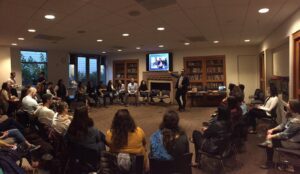Learning with JIMENA: A Series on Insights from Leaders in the Field
January 15th, 2021
As a Foundation that wants to always learn—one of our internal values is Hitlamdoot—we need to hear directly from leaders and practitioners in the field. Particularly at this moment, understanding what these individuals are experiencing, thinking, doing, and planning is integral to building our team’s knowledge base about the many subfields that makeup the broader world of Jewish education and engagement.
In this vein, representatives from different grantee-partners are speaking with the Foundation each month in Learning Sessions. While initially we planned for these sessions to be entirely internal, the insights and perspectives we are hearing from grantee-partners will be interesting and informative for others as well. We continue to approach our work with Kavanah, intention, to always elevate the efforts of others who help us pursue our mission. And we look forward to sharing brief recaps of each Learning Session. Read the first recap on learnings from Daniel Septimus, CEO of Sefaria, and the second recap from Deborah Meyer, founder and CEO, and Rabbi Tamara Cohen, VP of Program Strategy, Moving Traditions
Learning Session Guest: Sarah Levin, Executive Director, JIMENA
Sarah Levin, Executive Director of JIMENA (Jews Indigenous to the Middle East and North Africa), first shared a personal anecdote to provide context for the conversation about JIMENA’s evolution:
I didn’t really connect my Sephardic heritage with the larger Jewish community until I took trips to Israel as a teenager, and even more so when I graduated college. It was in Israel where I discovered that this part of my heritage is connected to the Jewish people.
Organization Background
 When Israel was founded, 650,000 of the one million Sephardic Jews from Middle Eastern and North African countries fled to Israel as stateless refugees and today their descendants comprise more than half of Israel’s Jewish population. The remaining refugees dispersed to countries throughout the world, and their experiences have been ignored and forgotten. Here in California there is an estimated 200,000 Mizrahi Jews, with the Iranian Jewish community in Southern California comprising one of the largest Middle Eastern diasporic communities in the world. Sarah’s feeling of disconnectedness from Sephardic community was shared by many of the children and grandchildren of JIMENA’s founders when they created the organization in 2002. Shortly after 9/11, a group of San Francisco Bay Area Jews from North Africa began to gather for the “purpose of redress and acknowledgement of what was taken from them and destroyed,” Sarah notes.
When Israel was founded, 650,000 of the one million Sephardic Jews from Middle Eastern and North African countries fled to Israel as stateless refugees and today their descendants comprise more than half of Israel’s Jewish population. The remaining refugees dispersed to countries throughout the world, and their experiences have been ignored and forgotten. Here in California there is an estimated 200,000 Mizrahi Jews, with the Iranian Jewish community in Southern California comprising one of the largest Middle Eastern diasporic communities in the world. Sarah’s feeling of disconnectedness from Sephardic community was shared by many of the children and grandchildren of JIMENA’s founders when they created the organization in 2002. Shortly after 9/11, a group of San Francisco Bay Area Jews from North Africa began to gather for the “purpose of redress and acknowledgement of what was taken from them and destroyed,” Sarah notes.
The mission of JIMENA grew from this history and experience. Today, JIMENA works to achieve universal recognition for the heritage and history of the 850,000 indigenous Jewish refugees from the Middle East and North Africa and their descendants.
Sarah adds, “We can’t talk about JIMENA without acknowledging that Jewish people are indigenous to the Middle East and have had a continuous and ongoing presence in the region for nearly 3,000 years. We must acknowledge that there were periods of time when Jewish communities in Arab and Muslim countries thrived and the experiences of Mizrahi and Sephardic Jews, now and throughout history, isn’t monolithic whatsoever. There is incredible diversity in the culture, history, and experiences of Jewish people from the Middle East and North Africa.”
JIMENA’s Two Main Areas
JIMENA’s programs and partnerships fall into two main categories:
Initially JIMENA focused primarily on sending eye-witness speakers to college campuses to share their lived experiences as Jewish refugees from Arab countries and Iran , Sarah says. Today, our work is more expansive and we aim to serve as national hub and resource center for Jewish and non-Jewish groups seeking an access point to Sephardic Jewish life, leaders, and resources such as curriculum.
The education and engagement efforts also include JIMENA’s reach to about 400,000 individuals in the Arab world every week,  educating people in that region of the world about Sephardic Jews from the Middle East and North Africa. This is a growing area of work, premised on important relationships.
educating people in that region of the world about Sephardic Jews from the Middle East and North Africa. This is a growing area of work, premised on important relationships.
JIMENA’s programs also focus on elevating Mizrachi and Sephardic voices so they are better positioned within the Jewish community. Its new Sephardic Leaders Fellowship, for example, aims to educate and empower Mizrachi and Sephardic leaders in the community. Adds Sarah, “These types of programs that educate and reconnect passionate Sephardic professionals and lay leaders to traditional Sephardic knowledge and to community can potentially help create the type systemic changes that our Jewish communities need.”
JIMENA also produces curricula about Mizrachi and Sephardic Jews that is used in over 200 schools across the world. Learn more about JIMENA’s use of Hacaham HaYomi into these curriculum offerings.
Partnerships and DEI: A Connected Strategy
Partnerships are integral to JIMENA’s strategic approach to creating impact.
“We cannot do our work, cannot educate the public, and cannot advocate for the rights of Mizrachi and Sephardic Jews without partnerships,” Sarah adds. “Up to 80 percent of the programs JIMENA produces are in partnership with non-Sephardic organizations. We cannot strengthen Jewish communal efforts around DEI and support other Jewish institutions unless they have access to resources, knowledge, and information.”
Through JIMENA, partner organizations can access Sephardic thought leaders, rabbis, texts, and communities. JIMENA shares this access and knowledge with the hope that partner organizations will integrate what they’ve learned through JIMENA into their own programs and help their own communities become more diverse, inclusive, and better responsive to the needs of affiliated and unaffiliated Sephardic and Mizrahi Jews.
Adds Sarah, “We try to give practical knowledge, skills, and access to Jewish institutions through our partnership model and to strengthen their work around DEI. Thus, these partnerships enable JIMENA to work towards a more diverse and inclusive Jewish landscape that better “recognizes, reflects, and represents, Mizrachi and Sephardic Jews.”
This DEI work is—and has been—core to JIMENA’s purpose. Sarah notes, “We’ve been doing this work around DEI since we were formed – it’s the very essence of why we exist! JIMENA, like many other Sephardic organizations in the USA have followed in the tradition of Sephardic American Jews who have been here for hundreds of years and have worked both internally and externally to meet our own communities needs while navigating participation in mainstream Jewish spaces – often times unsuccessfully. JIMENA welcomes the emphasis to include Jews of Color in community, and, at the same time, there is still much work to be done to include and represent Mizrachi and Sephardic Jews appropriately.
Using Research to Create Impact
 In recent years, the plethora of studies about different Jewish demographics exposed a void in JIMENA’s toolkit. JIMENA now is laying the groundwork for a major study of Mizrachi and Sephardic Jews. It has a 50 member Sephardic Advisory Committee—comprised of rabbis, community leaders, philanthropists, and scholars—currently discussing what such research should focus on and seek to find.
In recent years, the plethora of studies about different Jewish demographics exposed a void in JIMENA’s toolkit. JIMENA now is laying the groundwork for a major study of Mizrachi and Sephardic Jews. It has a 50 member Sephardic Advisory Committee—comprised of rabbis, community leaders, philanthropists, and scholars—currently discussing what such research should focus on and seek to find.
“Through an intensive process it’s quite clear that we need reliable demographic data and we also need qualitative data,” says Sarah. “Accurate numbers can help shape the communal landscape and inform how organizations serve and represent Mizrachi and Sephardic Jews. We are particularly interested in examining young adult and college aged Sephardic and Mizrahi Jews.”
Looking Ahead to Create Change
The importance of naming cannot be understated regarding Sephardic communities. “The majority of Sephardic leaders who I work with agree that we need more consensus and consent around language,” adds Sarah. “Who are we? How do we want to be defined, labeled, and represented in mainstream Jewish and non-Jewish spaces? We need to be provided with the space to decide how we want to fit within the frame of DEI initiatives and research. Many people are frustrated with labels and stereotypes that have been projected onto Sephardic communities – especially as the vast majority of Sephardic leaders are marginalized and removed from mainstream Jewish spaces, including spaces that focus on DEI.”
Mizrachi and Sephardic communities and cultures are incredibly diverse and many leaders carry traditions that are relevant today. There are communities of Sephardic rabbis and thought leaders that have a great deal of traditional knowledge on how the larger Jewish community can move forward towards building more inclusive, equitable communities.
We want to push the broader Jewish community to “go back to these ‘Sephardic well-springs’ to learn ancient communal modalities and practices that may help us all be more inclusive and meet the current needs of diverse Jewish communities.” Sarah says.